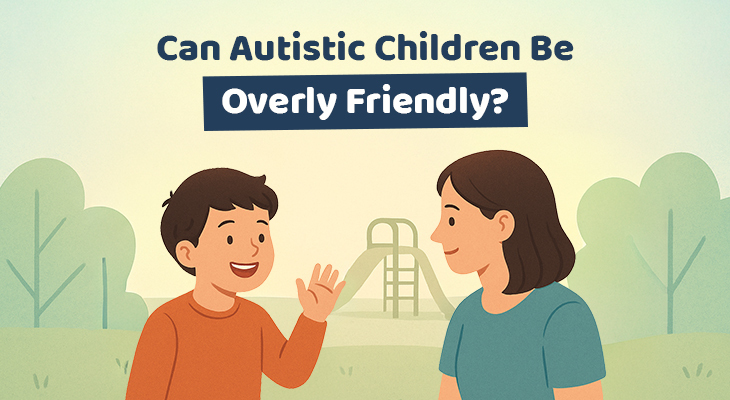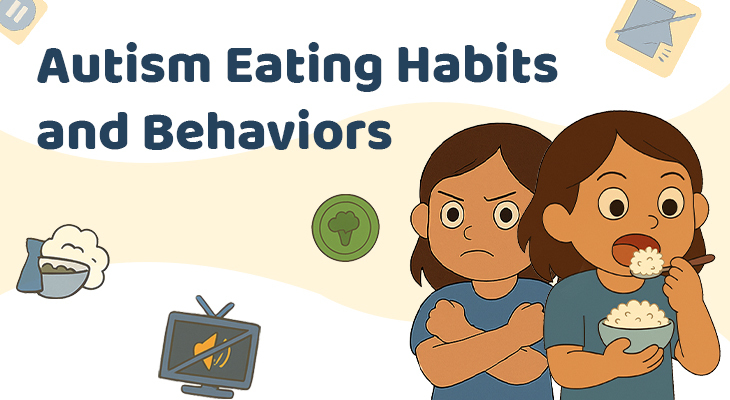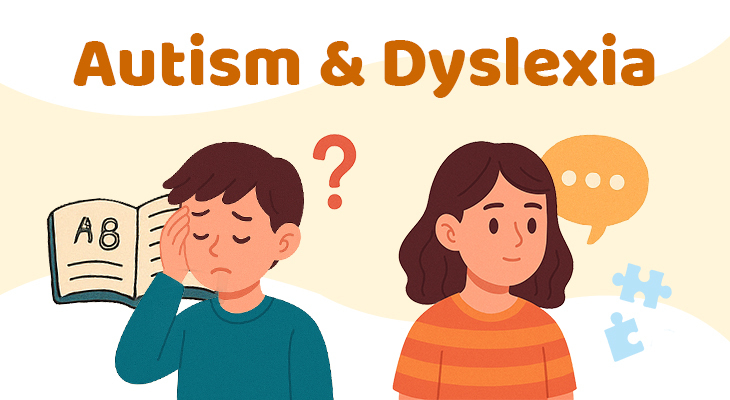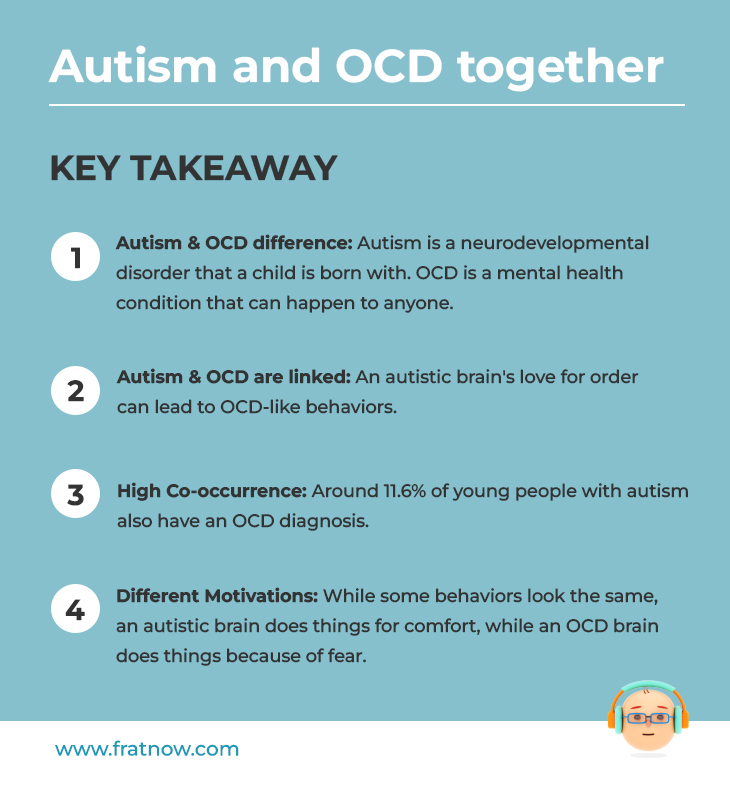
Download Download & share this Knowledge card in your network [Free Download]
Introduction
Hi! My name is Mia. You might remember me from my blogs about my sleepy brain and my food rules. My brain is super special, and it works in its own unique ways because I’m autistic. Sometimes, my brain likes things to be just so, and it can get really busy trying to make sure everything is perfect and safe.
Imagine my brain is like a very organized librarian. This librarian likes to put every book in its exact place and in its exact order. If a book is even a little bit out of place, the librarian gets a very, very strong feeling that something is wrong! And then the librarian just has to fix it, or that strong feeling won’t go away.
Sometimes, this feeling for order and safety gets super, super big, and it makes me do things over and over again. My grown-ups say that some kids, even kids who aren’t autistic, have these big feelings and do these repeated actions. They call it OCD, which means Obsessive-Compulsive Disorder. But my grown-ups told me that autism and OCD are very different. They say that my autism is a neurodevelopmental disorder, which is a brain thing I was born with. But OCD is a mental health condition that can happen to anyone. This is where it gets super tricky, because the behaviors that each brings out are quite similar and have an overlap.
In this blog, I want to tell you all about how my autistic brain sometimes feels these big, insistent feelings, what kinds of things I feel I have to do, and why it’s so important for my grown-ups to understand and help me when my brain gets stuck.
Table of Contents
- Introduction
- Why My Brain Needs Things to be “Just So”
- My Brain’s “What If” Worries (Obsessions)
- My Body’s “Have To” Actions (Compulsions)
- The Biggest Overlap: Autistic Love vs. OCD Fear
- How These Feelings Make My Day Tricky
- My Special “Unstuck” Helpers
- My Wish for Grown-Ups
- Conclusion
- Did You Know?
- References
Why My Brain Needs Things to be "Just So"
My grown-ups explain that because I’m autistic, my brain sometimes sees the world with extra-special detail. This is amazing for things like finding patterns or remembering tiny facts! But it also means my brain really, really likes predictability and things to stay the same. When things change, or aren’t quite right, it can feel very uncomfortable or even a bit scary.
When this feeling gets super strong, it’s like my brain gets a message that says, “Warning! Something is wrong or not safe! You must fix it!” My grown-ups say this is where my brain is acting with a little bit of OCD (Obsessive Compulsive Disorder). And then my brain just can’t stop thinking about it until it feels fixed. It’s not that I want to do these things over and over; it’s that my brain tells me I have to, or a bad feeling will stay or something bad might happen. It’s very hard to ignore.
My Brain's "What If" Worries (Obsessions)
These are the big, insistent thoughts that pop into my head and won’t leave. My grown-ups call them “obsessions.” They often start with “What if…?” and they make my brain feel all tight and worried. My grown-ups tell me that these worries that get stuck are the obsessions part of my OCD (Obsessive Compulsive Disorder). These worries can be about things like germs, keeping my things in perfect order, or making sure I didn’t forget something important. It’s like my brain gets stuck on a song that plays over and over, and I can’t make it stop. Some examples of my “What If” Worries are as follows:
"What if I touched something dirty?"
Then I feel like I have to wash my hands over and over until they feel completely clean.
"What if my toys aren't in the perfect line?"
Then I worry that something bad might happen, or that my whole room will feel messy inside my head.
"What if I forgot something important?"
Even if I just checked, my brain tells me I need to check again and again, like checking if the door is locked even if I saw my grown-up lock it.
"What if this color or number isn't right?"
My brain might get stuck on a certain color that feels “wrong” or a number that doesn’t feel “even,” and it makes me feel very uncomfortable until it’s changed.
My Body's "Have To" Actions (Compulsions)
When my brain gets those big “what if” worries, my body sometimes feels like it has to do certain actions to make the worry go away. My grown-ups call these “compulsions.” It’s like my body is trying to make my brain feel safe again. These actions are like a secret set of instructions that I feel I have to follow, even when I don’t want to. It’s hard to stop these actions, even when my grown-ups tell me it’s okay. My brain just won’t let me.
Lining things up
I might spend a long time lining up my crayons, or my cars, or my shoes, until they are in a perfectly straight line or a perfect pattern.
Checking things repeatedly
I might check if the stove is off, or if my backpack is packed correctly, or if my light switch is really, really off, many times.
Repeating words or movements
I might feel like I have to say a word a certain number of times, or tap my foot in a certain rhythm, to make a bad feeling go away or prevent something bad from happening.
Arranging or ordering
My books, my clothes, even the food on my plate might have to be arranged in a very specific way before I can start.
The Biggest Overlap: Autistic Love vs. OCD Fear
This part is very important, because this is where my brain gets really, really tricky for grown-ups to understand.
My Autistic Brain's Love for Order
My grown-ups know that my brain really, really loves things to be a certain way because it feels comfortable. Like when I line up my toys, I do it because it feels good and looks nice. It helps me feel happy and calm. My brain just loves patterns and order.
My OCD Brain's "Have to" Actions
But my OCD is different. My grown-ups told me that when my brain gets a big “what if” worry, it makes me do an action to try and stop a bad thing from happening. I don’t do it because it feels good. I do it because my brain is scared, and it tells me I have to.
This is the confusing part. My grown-ups say sometimes an action that I used to do for fun, like lining up my toys for my autistic brain, can get taken over by my OCD. Then, what used to be a fun activity becomes something my brain feels compelled to do out of fear. That’s when my grown-ups get confused, because they’re not sure if I’m doing it because it feels good or because I’m scared. But I know the difference in my heart.
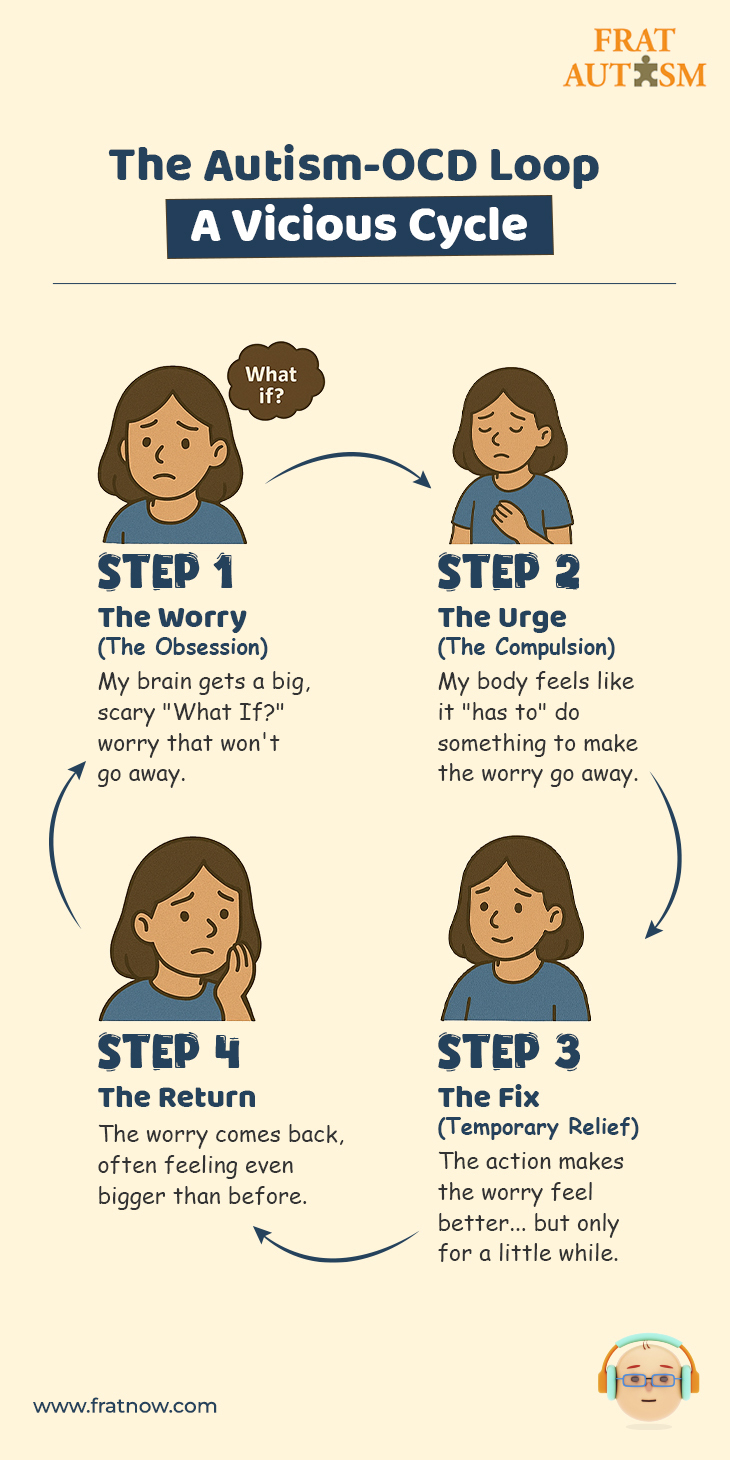
Download Download & share this infograph card in your network [Free Download]
How These Feelings Make My Day Tricky
When my brain gets stuck in these “what if” worries and “have to” actions, it makes my day feel very tricky and sometimes very long.
- It takes up all my time: I might spend so much time lining up my toys that I don’t have time to play with them. Or I might be late for school because I couldn’t stop checking my backpack.
- It makes me tired: Doing the same things over and over makes my brain and body feel very tired. It’s like running a race that never ends.
- It makes me feel worried and frustrated: The feelings of not being able to stop, or the fear that something bad might happen, can make me feel very anxious or even grumpy.
- Grown-ups sometimes get confused: My grown-ups might not understand why I have to do these things, and sometimes they get impatient. That makes me feel sad and misunderstood.
My Special "Unstuck" Helpers
Even when my brain feels stuck, my grown-ups and I are learning some really good “unstuck” helpers. These are the things that make my brain feel a little safer, so it doesn’t have to keep doing the “have to” actions as much.
[1] My grown-up's calm voice
When my brain is stuck, a quiet, calm grown-up who understands helps me so much. They don’t get mad, they just remind me that I’m safe and it’s okay.
[2] Taking a "brain break"
Sometimes, moving to a quiet space, or doing something calming like listening to music or squeezing a stress ball, helps my brain feel less overwhelmed.
[3] Small steps to try something different
My grown-ups don’t ask me to stop all at once. Sometimes they ask if I can do my “have to” action just one less time, or wait just 5 more seconds before doing it. It’s tiny steps, but it helps my brain learn to be a little less stuck.
[4] Talking about the feelings
My grown-ups help me find words for my worried feelings. When I can say, “My brain feels stuck on the door,” it helps them understand and helps me feel less alone with the big feeling.
[5] Using timers or visual schedules
Knowing exactly when it’s time to stop an action, or what comes next, helps my brain feel more in control and less worried.
[6] Special helpers who know about stuck brains
Sometimes, a special helper like a therapist helps my grown-ups and me learn ways to teach my brain to feel safe without doing all the “have to” actions. They are like brain coaches!
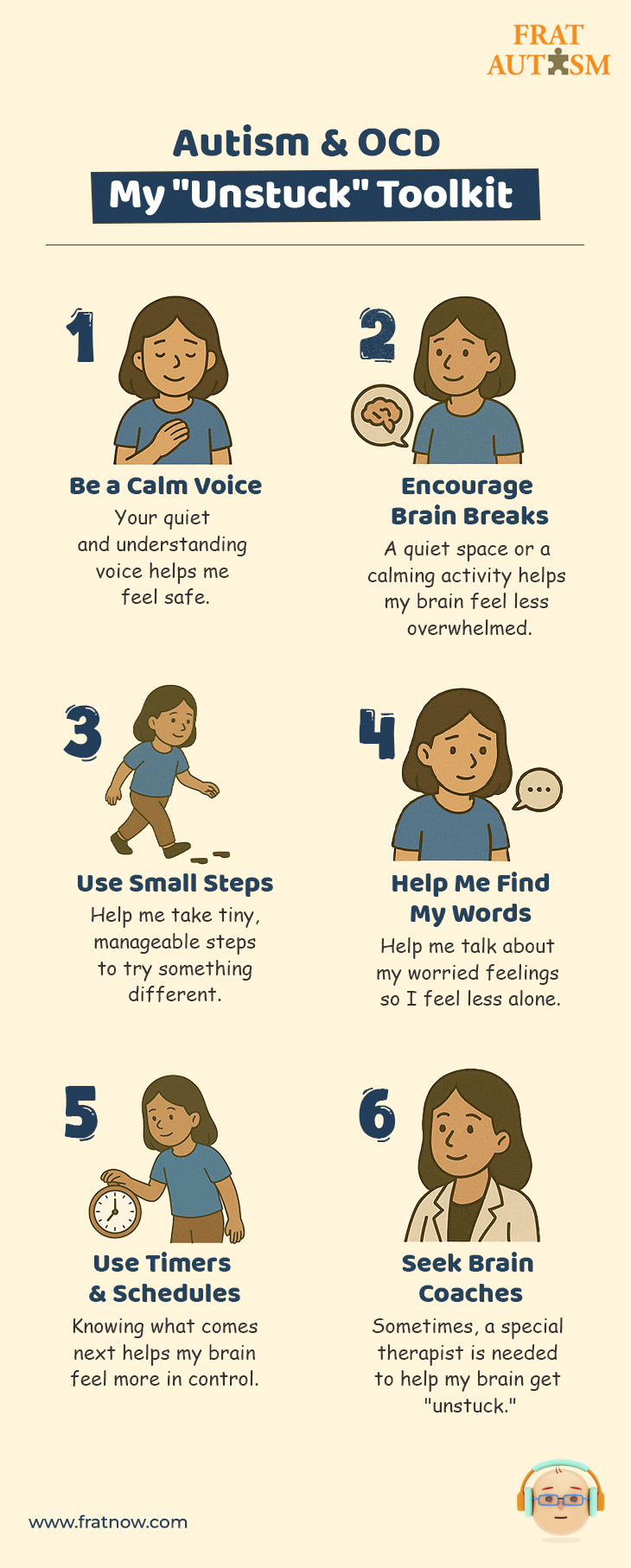
Download Download & share this infograph card in your network [Free Download]
My Wish for Grown-Ups
So, that’s my story about when my brain gets stuck. It can be tricky, and sometimes very hard to stop. My biggest wish for grown-ups is this:
Please understand it’s not my fault when my brain feels stuck. It’s a very strong feeling, and it makes me do things I sometimes don’t want to do. Thank you for being patient and for helping me find all my “unstuck” helpers. Because more than anything, I just want my brain to feel calm and safe, so I can have more time for playing and learning, and for all the adventures of the day.
Conclusion
Thank you for journeying with Mia into the complex world of autism and OCD together. Her honest words illuminate how deeply intertwined sensory sensitivities, a need for predictability, and intense anxieties can lead to repetitive thoughts and behaviors for autistic children. What might appear as rigid or defiant actions from the outside is often a child’s intense effort to regulate their internal world and find a sense of safety.
We hope Mia’s story has offered invaluable insights, fostering deeper empathy and equipping you with practical ways to support the autistic children in your lives when their brains get “stuck.” With patience, understanding, and the right “unstuck” helpers, we can empower them to navigate these challenges, giving them more freedom and joy in their daily lives.
FRAT® Test - Key Facts To Know
Of the 20,000+ individuals tested with the FRAT® test, a significant percentage showed positive results, indicating the presence of Folate Receptor Autoantibodies. Supplementation with alternative treatments like folinic acid has demonstrated improvements in quality of life for many of these individuals.
A FRAT® user’s TikTok video, sharing her child’s positive transformation following a positive FRAT® test result, went viral. Since its posting, the video has garnered an impressive 800K views, 79K likes, 27K shares, 33K bookmarks, and over 3K comments. Watch the video below:
@kyra2532 LIFE CHANGING updates for children with autism. #autismmom #childwithautism #autismresearch #autismfamily ♬ original sound - Kyra
Note: This video is only available in
regions where TikTok is available.
Over the years, more than 1400 physicians have been prescribing the FRAT® Test, underscoring its growing recognition as a valuable diagnostic tool.
Here’s what Maxwell (Parent to an autistic child) has to say about the FRAT® test:

MAXWELL M.
References
- National Library of Medicine – Prevalence and Correlates of the Concurrence of Autism Spectrum Disorder and Obsessive Compulsive Disorder in Children and Adolescents: A Systematic Review and Meta-Analysis
- International OCD Foundation – OCD and Autism
- Medical News Today – What to know about OCD vs. Autism

